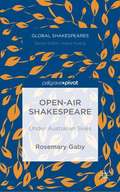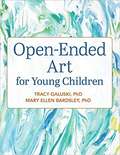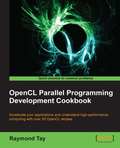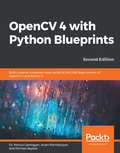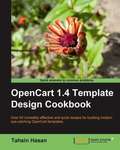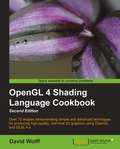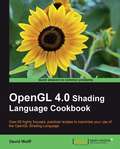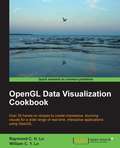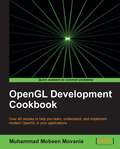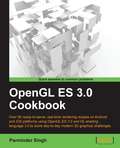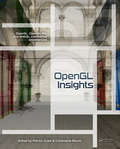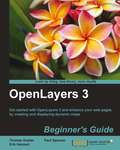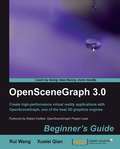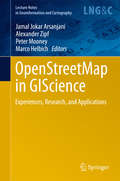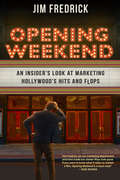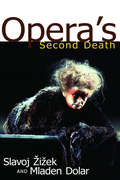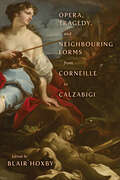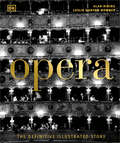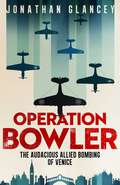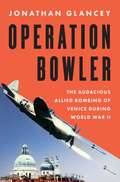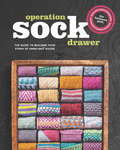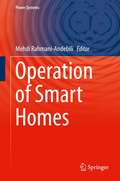- Table View
- List View
Open-Air Shakespeare: Under Australian Skies
by Rosemary GabyMany people today first encounter staged Shakespeare in an open-air setting. This book traces the history of open-air Shakespeares in Australia to investigate why the anomaly of adapting 400-year old plays under Australian skies exerts such a strong appeal.
Open-Ended Art for Young Children: Moving Beyond the Basics
by Tracy Galuski Mary Ellen BardsleyOpen-ended art is defined as art activity where children are free to use their imagination as they explore a variety of materials without a planned outcome. When teachers embrace open-ended art, they emphasize the process of creating and observe the developmental growth being experienced by the children. Open-ended art provides children an important opportunity to think about, feel, and express ideas. It allows teachers to slow down the pace of the day and appreciate the beauty that comes from simple experimentation with art materials. <p><p> There are many books available to educators that include art ideas and projects, but Open-Ended Art for Young Children goes beyond the basics to highlight why the field of early childhood education advocates for open-ended art and explains how to adapt to new ways of thinking about art. Authors Dr. Tracy Galuski and Dr. Mary Ellen Bardsley present, chapter by chapter, the challenges teachers encounter when faced with best practices and expectations related art process and product. Each chapter begins with a classroom vignette that describes the challenge, followed by a plethora of solutions grounded in research and illustrated through practical examples. Each chapter includes full-color pictures and photos and ends with an activity or investigation for reflection.
OpenCL Parallel Programming Development Cookbook
by Raymond TayOpenCL Parallel Programming Development Cookbook will provide a set of advanced recipes that can be utilized to optimize existing code. This book is therefore ideal for experienced developers with a working knowledge of C/C++ and OpenCL.This book is intended for software developers who have often wondered what to do with that newly bought CPU or GPU they bought other than using it for playing computer games; this book is also for developers who have a working knowledge of C/C++ and who want to learn how to write parallel programs in OpenCL so that life isn't too boring.
OpenCV 4 with Python Blueprints: Build creative computer vision projects with the latest version of OpenCV 4 and Python 3, 2nd Edition
by Michael Beyeler Dr. Menua Gevorgyan Arsen MamikonyanGet to grips with traditional computer vision algorithms and deep learning approaches, and build real-world applications with OpenCV and other machine learning frameworks Key Features Understand how to capture high-quality image data, detect and track objects, and process the actions of animals or humans Implement your learning in different areas of computer vision Explore advanced concepts in OpenCV such as machine learning, artificial neural network, and augmented reality Book Description OpenCV is a native cross-platform C++ library for computer vision, machine learning, and image processing. It is increasingly being adopted in Python for development. This book will get you hands-on with a wide range of intermediate to advanced projects using the latest version of the framework and language, OpenCV 4 and Python 3.8, instead of only covering the core concepts of OpenCV in theoretical lessons. This updated second edition will guide you through working on independent hands-on projects that focus on essential OpenCV concepts such as image processing, object detection, image manipulation, object tracking, and 3D scene reconstruction, in addition to statistical learning and neural networks. You'll begin with concepts such as image filters, Kinect depth sensor, and feature matching. As you advance, you'll not only get hands-on with reconstructing and visualizing a scene in 3D but also learn to track visually salient objects. The book will help you further build on your skills by demonstrating how to recognize traffic signs and emotions on faces. Later, you'll understand how to align images, and detect and track objects using neural networks. By the end of this OpenCV Python book, you'll have gained hands-on experience and become proficient at developing advanced computer vision apps according to specific business needs. What you will learn Generate real-time visual effects using filters and image manipulation techniques such as dodging and burning Recognize hand gestures in real-time and perform hand-shape analysis based on the output of a Microsoft Kinect sensor Learn feature extraction and feature matching to track arbitrary objects of interest Reconstruct a 3D real-world scene using 2D camera motion and camera reprojection techniques Detect faces using a cascade classifier and identify emotions in human faces using multilayer perceptrons Classify, localize, and detect objects with deep neural networks Who this book is for This book is for intermediate-level OpenCV users who are looking to enhance their skills by developing advanced applications. Familiarity with OpenCV concepts and Python libraries, and basic knowledge of the Python programming language are assumed.
OpenCart 1.4 Template Design Cookbook
by Tahsin HasanThis hands-on guide cuts short the preamble and gets straight to the point with practical recipes instead of just theoretical learning. Each recipe is specifically tailored to fulfill your appetite for creating professional visually stunning templates and themes for your OpenCart store.You may be the owner of an OpenCart web store or a designer working with OpenCart. If you want to customize OpenCart to unleash its enormous potential and elevate your store to the next level, this book is for you. You must have some experience with OpenCart and understand its basic features. You also need to know HTML and should be comfortable taking up some challenges in PHP and JavaScript programming.
OpenGL 4 Shading Language Cookbook - Second Edition
by David WolffOpenGL Shading Language 4 Cookbook is a hands-on guide that gets straight to the point - actually creating graphics, instead of just theoretical learning. Each recipe is specifically tailored to satisfy your appetite for producing real-time 3-D graphics using the latest GLSL specification.This book is for OpenGL programmers looking to use the modern features of GLSL 4 to create real-time, three-dimensional graphics. Familiarity with OpenGL programming, along with the typical 3D coordinate systems, projections, and transformations is assumed. It can also be useful for experienced GLSL programmers who are looking to implement the techniques that are presented here.
OpenGL 4 Shading Language Cookbook: Build high-quality, real-time 3D graphics with OpenGL 4.6, GLSL 4.6 and C++17, 3rd Edition
by David WolffOver 70 recipes that cover advanced techniques for 3D programming such as lighting, shading, textures, particle systems, and image processing with OpenGL 4.6Key FeaturesExplore techniques for implementing shadows using shadow maps and shadow volumesLearn to use GLSL features such as compute, geometry, and tessellation shadersUse GLSL to create a wide variety of modern, realistic visual effectsBook DescriptionOpenGL 4 Shading Language Cookbook, Third Edition provides easy-to-follow recipes that first walk you through the theory and background behind each technique, and then proceed to showcase and explain the GLSL and OpenGL code needed to implement them. The book begins by familiarizing you with beginner-level topics such as compiling and linking shader programs, saving and loading shader binaries (including SPIR-V), and using an OpenGL function loader library. We then proceed to cover basic lighting and shading effects. After that, you'll learn to use textures, produce shadows, and use geometry and tessellation shaders. Topics such as particle systems, screen-space ambient occlusion, deferred rendering, depth-based tessellation, and physically based rendering will help you tackle advanced topics. OpenGL 4 Shading Language Cookbook, Third Edition also covers advanced topics such as shadow techniques (including the two of the most common techniques: shadow maps and shadow volumes). You will learn how to use noise in shaders and how to use compute shaders.The book provides examples of modern shading techniques that can be used as a starting point for programmers to expand upon to produce modern, interactive, 3D computer-graphics applications.What you will learnCompile, debug, and communicate with shader programsUse compute shaders for physics, animation, and general computingLearn about features such as shader storage buffer objects and image load/storeUtilize noise in shaders and learn how to use shaders in animationsUse textures for various effects including cube maps for reflection or refractionUnderstand physically based reflection models and the SPIR-V Shader binaryLearn how to create shadows using shadow maps or shadow volumesCreate particle systems that simulate smoke, fire, and other effectsWho this book is forIf you are a graphics programmer looking to learn the GLSL shading language, this book is for you. A basic understanding of 3D graphics and programming experience with C++ are required.
OpenGL 4.0 Shading Language Cookbook
by David WolffThis hands-on guide cuts short the preamble and gets straight to the point - actually creating graphics, instead of just theoretical learning. Each recipe is specifically tailored to satisfy your appetite for producing real-time 3-D graphics using GLSL 4.0.If you are an OpenGL programmer looking to use the modern features of GLSL 4.0 to create real-time, three-dimensional graphics, then this book is for you. Familiarity with OpenGL programming, along with the typical 3D coordinate systems, projections, and transformations is assumed. It can also be useful for experienced GLSL programmers who are looking to implement the techniques that are presented here.
OpenGL Data Visualization Cookbook
by Raymond C. H. Lo William C. Y. LoOver 40 hands-on recipes to create impressive, stunning visuals for a wide range of real-time, interactive applications using OpenGL About This Book * Get acquainted with a set of fundamental OpenGL primitives and concepts that enable users to create stunning visuals of arbitrarily complex 2D and 3D datasets for many common applications * Explore interactive, real-time visualization of large 2D and 3D datasets or models, including the use of more advanced techniques such as stereoscopic 3D rendering. * Create stunning visuals on the latest platforms including mobile phones and state-of-the-art wearable computing devices Who This Book Is For This book is aimed at anyone interested in creating impressive data visualization tools using modern graphics hardware. Whether you are a developer, engineer, or scientist, if you are interested in exploring the power of OpenGL for data visualization, this book is for you. While familiarity with C/C++ is recommended, no previous experience with OpenGL is assumed. What You Will Learn * Install, compile, and integrate the OpenGL pipeline into your own project * Create interactive applications using GLFW and handle user inputs with callback functions * Use OpenGL primitives and features in the OpenGL Shading Language (GLSL) * Render complex 3D volumetric data with techniques such as data slicers and multiple viewpoint projection * Implement a hardware-accelerated data visualizer, heat map generator, point cloud rendering, perspective rendering, and alpha blending * Process images or video sources with texture mapping and custom fragment shader programs for image resizing and wrapping * Develop video see-through augmented reality applications with OpenGL * Visualize 3D models using meshes and surfaces with dynamic lighting In Detail OpenGL is a great multi-platform, cross-language, and hardware-accelerated graphics interface for visualizing large 2D and 3D datasets. Data visualization has become increasingly challenging using conventional approaches as datasets become larger and larger, especially with the Big Data evolution. From a mobile device to a sophisticated high-performance computing cluster, OpenGL libraries provide developers with an easy-to-use interface to create stunning visuals in 3D in real time for a wide range of interactive applications. This book provides easy-to-follow, hands-on tutorials to create appealing OpenGL-based visualization tools with minimal development time. We will first illustrate how to quickly set up the development environment in Windows, Mac, and Linux. Next, we will demonstrate how to visualize data for a wide range of applications using OpenGL, starting from simple 2D datasets to increasingly complex 3D datasets with more advanced techniques. Each chapter addresses different visualization problems encountered in real life and introduces the relevant OpenGL features and libraries in a modular fashion. By the end of this book, you will be equipped with the essential skills to develop a wide range of impressive OpenGL-based applications for your unique data visualization needs, on platforms ranging from conventional computers to the latest mobile/wearable devices. Style and approach This is an easy-to-follow, comprehensive Cookbook showing readers how to create an application with real-time, interactive data visualization in stereoscopic 3D. Each topic is explained in a step-by-step format. A range of hot topics is included, including data visualization on mobile and wearable platforms."
OpenGL Development Cookbook
by Muhammad Mobeen MovaniaThis hands-on Cookbook cuts through the preamble and gets straight to the point. OpenGL Development Cookbook is perfect for intermediate C++ programmers. Full of practical techniques for implementing amazing computer graphics and visualizations, using OpenGL. Crammed full of useful recipes, OpenGL Development Cookbook will help you exploit OpenGL to its full potential. OpenGL Development Cookbook is geared toward intermediate OpenGL programmers to take you to the next level and create amazing OpenGL graphics in your applications.
OpenGL ES 3.0 Cookbook
by Parminder SinghIf you are new to OpenGL ES or have some experience in 3D graphics, then this book will be extremely helpful in raising your expertise level from a novice to professional. The book implements more than 90 recipes to solve everyday challenges, helping you transition from a beginner to a professional.
OpenGL Insights
by Patrick Cozzi Christophe RiccioGet Real-World Insight from Experienced Professionals in the OpenGL CommunityWith OpenGL, OpenGL ES, and WebGL, real-time rendering is becoming available everywhere, from AAA games to mobile phones to web pages. Assembling contributions from experienced developers, vendors, researchers, and educators, OpenGL Insights presents real-world techniques
OpenLayers 3 Beginner's Guide
by Thomas Gratier<P><P>About This Book <P><P>Create and display maps online with the latest HTML5 features available, using the OpenLayers 3 library <P><P>Learn how to interact with the map and learn best practices to improve the loading time for a map <P><P>A practical beginner's guide, which also serves as a quick reference with useful screenshots and detailed code explanations <P><P>Who This Book Is For <P><P>Whether you are a hobbyist or a professional web developer, if you wish to use maps on your website, then this book is for you. A basic understanding of JavaScript will be helpful, but is not necessary. If you've never worked with maps before, this book will introduce you to some common mapping topics and will guide you through the OpenLayers library. Experienced developers can also use this book as a reference to OpenLayers 3 components and to further enhance their knowledge. <P><P>What You Will Learn <P><P>Build a complete, real-world OpenLayers application optimized for production use <P><P>Work with different raster data sources to create a base map <P><P>Overlay vector data sources and work with vector features directly <P><P>Customize the appearance of vector layers <P><P>Understand the concept of map projections and how to use them <P><P>Manage and work with interactions such as click and touch <P><P>Work with controls to enhance the user experience <P><P>Target mobile platforms and explore challenges presented by mobile development <P><P>In Detail <P><P>This book is a practical, hands-on guide that provides you with all the information you need to get started with mapping using the OpenLayers 3 library. <P><P>The book starts off by showing you how to create a simple map. Through the course of the book, we will review each component needed to make a map in OpenLayers 3, and you will end up with a full-fledged web map application. You will learn the key role of each OpenLayers 3 component in making a map, and important mapping principles such as projections and layers. You will create your own data files and connect to backend servers for mapping. A key part of this book will also be dedicated to building a mapping application for mobile devices and its specific components.
OpenSceneGraph 3 Cookbook
by Xuelei Qian Rui WangThis is a cookbook full of recipes with practical examples enriched with code and the required screenshots for easy and quick comprehension. You should be familiar with the basic concepts of the OpenSceneGraph API and should be able to write simple programs. Some OpenGL and math knowledge will help a lot, too.
OpenSceneGraph 3.0: Beginner's Guide
by Xuelei Qian Rui WangWritten with a fast-paced but friendly and engaging approach, this Packt Beginner's Guide is designed to be placed alongside the computer as your guide and mentor. Step-by-step tutorials are bolstered by explanations of the reasoning behind what you are doing. You will quickly pick up the necessary skills, tips, and tricks for creating successful 3D graphics with practical examples that help you to learn by experiment and play.This book is intended for software developers who are new to OpenSceneGraph and considering using it in their applications. It is assumed that you have basic knowledge of C++ before using this book, especially the standard template library (STL) constructs, of which OSG makes extensive use. Some familiarity with design patterns as implemented in C++ is also useful, but is not required.You need to be familiar with OpenGL, the standard cross-platform low-level 3D graphics API. We'll meet some maths in the book--geometry and linear algebra--and familiarity with these topics will be great, but you don't need to be a maths whiz to use this book.
OpenStreetMap in GIScience
by Jamal Jokar Arsanjani Alexander Zipf Peter Mooney Marco HelbichThis edited volume presents a collection of lessons learned with, and research conducted on, OpenStreetMap, the goal being to promote the project's integration. The respective chapters address a) state-of-the-art and cutting-edge approaches to data quality analysis in OpenStreetMap, b) investigations on understanding OpenStreetMap contributors and the nature of their contributions, c) identifying patterns of contributions and contributors, d) applications of OpenStreetMap in different domains, e) mining value-added knowledge and information from OpenStreetMap, f) limitations in the analysis OpenStreetMap data, and g) integrating OpenStreetMap with commercial and non-commercial datasets. The book offers an ideal opportunity to present and disseminate a number of cutting-edge developments and applications in the field of geography, spatial statistics, GIS, social science, and cartography.
Opening Weekend: An Insider's Look at Marketing Hollywood's Hits and Flops
by Jim FredrickIn a world where movie marketers are the stars of the story, Opening Weekend: An Insider's Look at Marketing Hollywood's Hits and Flops recounts Jim Fredrick’s journey through the realm of movie marketing. Fredrick offers readers exclusive access to behind-the-scenes anecdotes and firsthand accounts of working with studio executives and navigating relationships with famous movie stars and directors.After starting his career in 1983 as a trailer editor and producer at famed advertising boutique Intralink, Jim Fredrick went on to serve as president of marketing at Castle Rock Entertainment; senior vice president of creative advertising at Warner Bros.; and executive vice president of marketing at Sony Screen Gems. In 2011, he founded his own company, Jim Fredrick Motion Picture Marketing. Across a span of thirty-five years, Fredrick’s roles as a trailer maker and studio executive allowed him to craft advertising campaigns for a range of movies, from such iconic cinematic gems as The Shawshank Redemption to the widely beloved Harry Potter franchise, to commercial failures like The Adventures of Pluto Nash and Fired Up! Opening Weekend explores the intricacies of the lesser-known business of film distribution and marketing, unraveling the complex mechanisms through which movies are sold to discriminating audiences. Replete with triumphs, setbacks, and the relentless spirit that drives the creation and promotion of cinematic masterpieces, Opening Weekend promises an enthralling glimpse into the previously untold world of Hollywood movies.
Opera in Performance: Analyzing the Performative Dimension of Opera Productions (Routledge Advances in Theatre & Performance Studies)
by Clemens RisiOpera in Performance elucidates the performative dimension of contemporary opera productions. What are the most striking and decisive moments in a performance? Why do we respond so strongly to stagings that transform familiar scenes, to performers’ bodily presence, and to virtuosic voices as well as ill-disposed ones? Drawing on phenomenology and performance theory, Clemens Risi explains how these moments arise out of a dialogue between performers and the audience, representation and presence, the familiar and the new. He then applies these insights in critical descriptions of his own experiences of various singers, stagings, and performances at opera houses and festivals from across the German-speaking world over the last twenty years. As the first book to focus on what happens in performance as such, this study shifts our attention to moments that have eluded articulation and provides tools for describing our own experiences when we go to the opera. This book will particularly interest scholars and students in theater and performance studies, musicology, and the humanities, and may also appeal to operagoers and theater professionals.
Opera's Second Death
by Slavoj Zizek Mladen DolarOpera's Second Death is a passionate exploration of opera - the genre, its masterpieces, and the nature of death. Using a dazzling array of tools, Slavoj Zizek and coauthor Mladen Dolar explore the strange compulsions that overpower characters in Mozart and Wagner, as well as our own desires to die and to go to the opera.
Opera, Tragedy, and Neighbouring Forms from Corneille to Calzabigi
by Blair HoxbySince the nineteenth century, some of the most influential historians have portrayed opera and tragedy as wholly distinct cultural phenomena. These historians have denied a meaningful connection between the tragedy of the ancients and the efforts of early modern composers to arrive at styles that were intensely dramatic. Drawing on a series of case studies, Opera, Tragedy, and Neighbouring Forms from Corneille to Calzabigi traces the productive, if at times rivalrous, relationship between opera and tragedy from the institution of French regular tragedy under Richelieu in the 1630s to the reform of opera championed by Calzabigi and Gluck in the late eighteenth century. Blair Hoxby and his fellow contributors shed light on “neighbouring forms” of theatre, including pastoral drama, tragédie en machines, tragédie en musique, and Goldoni’s dramma giocoso. Their analysis includes famous masterpieces by Corneille, Voltaire, Metastasio, Goldoni, Calzabigi, Handel, and Gluck, as well as lesser-known artists such as Luisa Bergalli, the first female librettist to write for the public theatre in Italy. Opera, Tragedy, and Neighbouring Forms from Corneille to Calzabigi delves into a series of quarrels and debates in order to illuminate the history of seventeenth- and eighteenth-century theatre.
Opera: The Definitive Illustrated History
by Leslie Dunton-Downer Alan RidingExperience the passion and drama of the world&’s greatest operas with this sumptuously illustrated visual guide.Immerse yourself in more than 400 years of the world&’s most celebrated operas and discover the fascinating stories behind them. Explore the lives of singers such as Maria Callas, Luciano Pavarotti, and Jonas Kaufmann. Meet composers like Mozart, Wagner, and Britten, and the librettists with whom they collaborated to create the magical blend of words and music that make up opera.From its origins in the 17th-century courts of Italy to live screenings in public spaces today, Opera: The Definitive Illustrated Story follows the history of opera from Monteverdi&’s L'Orfeo in 1607, to Cosi fan Tutte, La Bohème, and modern operas such as Brokeback Mountain. It explains musical terminology, traces historical developments, and sets everything in a cultural context.This awe-inspiring opera book further features:-Includes all of the most important operas from the Renaissance to the 21st century-Profiles the key composers, librettists, performers, and companies, with details of their lives, works, and influence-Arranged in chronological order to show the evolution of the genre-Clear, informative explanation of musical terminology and different types of operaThis book revels in the sets and costumes that make up the grand spectacle of opera. It also explores the great opera houses of the world, such as La Scala, Milan, the Met in New York, and the Sydney Opera House. Opera: The Definitive Illustrated Story is the essential book for anyone who wants to understand and enjoy the constantly evolving world of this beloved art form.Did you know that there are more than 25,000 opera performances per year worldwide? Opera: The Definitive Illustrated Story can be regarded as the most lavishly illustrated history of opera currently available, covering all of the most important operas from the Renaissance to the 21st century, and is completely global in scope. A must-have volume for opera buffs, whether as a gift or self-purchase, if you&’re a music lover looking for an accessible introduction to opera, then this is the book for you!
Operation Bowler: The Audacious Allied Bombing of Venice
by Jonathan Glancey21st March 1945. 1530 hours. Bursting through a hazy sky, dozens of Allied fighters and bombers sweep over German-occupied Venice. Their mission – destroy Germany&’s strategic outposts nestled along the port, while leaving the floating city unscathed. As bombs rained down upon Europe, flattening city after city, Venice – La Serenissima; home of Titian and Veronese; immortalised in the serene landscapes of Canaletto – remained sacrosanct. Its artistic and architectural treasure too considerable, too precious to risk destruction. But, as the push up through Italy reached its final, gruelling months, the Allies were confronted with a terrible dilemma. The ancient city of Venice was now closer and closer to the line of fire. As casualties mounted, the value of art, of history seemed diminished – just a month earlier Allied bombers had reduced the ancient hilltop abbey of Monte Cassino to a stony husk. In a gripping tale, bestselling author Jonathan Glancey reveals the thrilling history of &‘Operation Bowler&’. Joining audacious Wing Commander George Westlake DFC and his elite team, Operation Bowler explores how an unlikely squad of pilots executed one of the most meticulous and complex air raids of the Second World War, sparing not only Venice, but its people.
Operation Bowler: The Audacious Allied Bombing of Venice during World War II
by Jonathan GlanceyA story of incredible military daring—set against the splendor of Venice—that tells how an unlikely squad of pilots executed the most meticulous air raid of World War II.March 21st, 1945. Bursting through a hazy sky, dozens of Allied fighters and bombers sweep over German-occupied Venice. Their mission: destroy Germany&’s strategic outposts nestled along the port, while leaving the floating city unscathed. As bombs rained down upon Europe, flattening city after city, Venice—La Serenissima; home of Titian and Veronese; immortalized in the serene landscapes of Canaletto—remained sacrosanct. Its artistic and architectural treasure too considerable, too precious to risk destruction. But as the push up through Italy reached its final, grueling months, the Allies were confronted with a terrible dilemma. The ancient city of Venice was now closer and closer to the line of fire. As casualties mounted, the value of art—of history—seemed diminished; just a month earlier Allied bombers had reduced the ancient hilltop abbey of Monte Cassino to a stony husk. In this vivid narrative, bestselling author Jonathan Glancey reveals the thrilling story of Operation Bowler. Following the exploits of audacious Wing Commander George Westlake and his elite team, Operation Bowler explores how an unlikely squad of pilots executed perhaps the most meticulous and complex air raid of World War II, sparing not only Venice but also its people.
Operation Sock Drawer: The Guide to Building Your Stash of Hand-Knit Socks
by Knitmore GirlsKnit yourself a drawer of beautiful socks with the Knitmore Girls Inspired by the gorgeous sock drawers of Susan B. Anderson, Jasmin and Gigi of The Knitmore Girls podcast started the hashtag #operationsockdrawer in an effort to knit a collection of socks just as photo worthy. Tens of thousands of knitters have since joined the campaign to knit more pretty socks and the hashtag has grown to more than 200k tags on social media. Think of Operation Sock Drawer as your sock knitting survival guide. In it you'll find: • 20 original designer sock patterns--more than enough to fill your first drawer. • Great how-ton information on knitting a variety of toe shapes, heel styles, options for comfortable ankles, and more! • Darn it! Don't toss old socks, repair them with simple darning techniques. • Bonus information on knitting socks two at a time, how to make great yarn to pattern matches, and how to overcome second sock syndrome. Grab your needles and a skein of yarn, and then join The Knitmore Girls on their mission to expand sock collections around the globe.
Operation of Smart Homes (Power Systems)
by Mehdi Rahmani-AndebiliThis book presents the latest research advancements in the operation of smart homes. It comprises new operation techniques including cooperative distributed energy scheduling, framework to react to malicious cyberattacks, framework for demand-side management, and framework for the design of smart homes to support residents’ wellness as well as new optimization techniques such as stochastic model predictive control and multi-time scale optimization. In addition, the book analyzes 11,000 studies that have been indexed in scientific databases and categorizes them based on various data points, including the field and the subject of the research, the name of the institutions, and the nationality of the authors.Presents new operation techniques of smart homes;Introduces new optimization techniques for operation of smart homes;Analyses 11,000 studies and categorizes them based on different data points.
